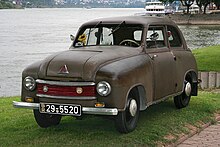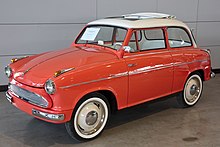Lloyd Motoren Werke G.m.b.H. (Lloyd Engine Works) was a German automobile manufacturer, created in 1908 and owned by the Norddeutscher Lloyd shipping company. The factory was in Bremen. The company operated under a variety of different names throughout the decades, but their products were nearly always badged with the Lloyd marque. Originally a manufacturer of luxury cars, the company was folded into the Borgward Group in 1929, with the brand not used on passenger cars again until 1950. Production ended for good in 1963, although a successor company continued trading until 1989, selling replacement parts, as well as manufacturing engines for snowmobiles and boats.
 | |
| Industry | Automotive |
|---|---|
| Founded | 1908 |
| Defunct | 1963 |
| Fate | Bankruptcy |
| Headquarters | Bremen, Germany |
| Products | Automobiles |
| Parent | Norddeutscher Lloyd |
The German Lloyd marque had no connection with the British Lloyd Cars Ltd company active between 1936 and 1951.
1908–1937
The first cars were licence-built Kriéger electric vehicles. Petrol-engined models followed in 1908, using 3685 cc engines, but few were made. The Belgian electrical engineer, Paul Mossay, was employed for four years as chief engineer, designing both engines and electric vehicles.[1]: 78 In 1914, the company merged with Hansa to become Hansa-Lloyd Werke AG. The company was never on a sound financial footing and changed names and badging on a number of occasions.[2] Most of the Hansa/Lloyd cars made during that period were branded as "Hansa". The "Hansa-Lloyd" name mainly attached to commercial vehicles, with the exception of the Treff-Aß and the Trumpf-Aß. The company was integrated in the Borgward group after the purchase of Hansa by Carl F. W. Borgward in 1929, and car production ceased.
Until 1937, the Hansa-Lloyd brand was used on a number of commercial vehicles (trucks and buses), from the one-ton "Express" to the five-ton "Merkur". They were largely replaced by Borgward-branded vehicles, but a few models were sold in 1938 with just "Hansa" badging.[3]
1950–1963








Lloyd as a stand-alone name only entered mass-production of cars and light trucks in 1950, when the company became Lloyd Motoren Werke GmbH – still in Bremen. The very first cars (the Lloyd 300) were wood- and fabric-bodied. Between 1953 and 1954, thin, rolled steel gradually replaced the original fabric shell (Lloyd 400), but wood framing was still used within the doors and elsewhere.
The Lloyd 250 was called "Prüfungsangst-Lloyd" ("Lloyd for exam nerves") because they appealed to drivers who had older driving licenses and could drive the car without having to pass the new test for drivers of cars with a cubic capacity of over 250 cc, a test which was introduced in a legal reform in the mid-1950s. With an engine producing only 11 PS (DIN), the Lloyd designers saw a need for saving weight, and thus offered the LP 250 without a back seat, bumpers, hub caps or trims. However, most buyers ordered the LP 250 V with those features as optional extras.
Overall, the vehicles filled the need for small, cheap cars, which were characteristic of post-war Germany, and they provided a comparatively high standard of comfort and reliability. For several years in the 1950s, they rose to third place in the annual licensing statistics, behind only Volkswagen and Opel. In spite of that success, there was little prestige gained in driving a Lloyd. In the vernacular, the Lloyd 300 was called "Leukoplastbomber", due to the owners' habit of repairing nicks in the fabric of the body with sticking plaster called Leukoplast. A contemporary derisive verse went "Wer den Tod nicht scheut, fährt Lloyd" ("He who is not afraid of death, drives a Lloyd").
Pietro Frua designed a coupé based on the Lloyd Alexander, which was presented at the Turin Motor Show in November 1958.
The parent company failed in 1961 but cars were still made up to 1963. By that time, the LP 900 was named "Borgward Arabella" instead of "Lloyd Arabella".
Models
| Type | Body style | Period | Engine | cubic capacity | hp (DIN) | Gears | Speed |
|---|---|---|---|---|---|---|---|
| Lloyd LP 300 | saloon | 1950–1952 | 2 cylinders two-stroke | 293 | 10 | 3 | 75 km/h (47 mph) |
| Lloyd LS 300 / LK 300 | LS: estate car LK: van | 1951–1952 | 2 cylinders two-stroke | 293 | 10 | 3 | 75 km/h (47 mph) |
| Lloyd LC 300 | coupé | 1951–1952 | 2 cylinders two-stroke | 293 | 10 | 3 | 75 km/h (47 mph) |
| Lloyd LP 400 | saloon | 1953–1957 | 2 cylinders two-stroke | 386 | 13 | 3 | 75 km/h (47 mph) |
| Lloyd LS 400 / LK 400 | LS: estate car LK: van | 1953–1957 | 2 cylinders two-stroke | 386 | 13 | 3 | 75 km/h (47 mph) |
| Lloyd LC 400 | convertible | 1953–1957 | 2 cylinders two-stroke | 386 | 13 | 3 | 75 km/h (47 mph) |
| Lloyd LT 500 | van / 6-seater minivan[4] | 1953–1957 | 2 cylinders two-stroke | 386 | 13 | 3 | 75 km/h (47 mph) |
| Lloyd LP 250 and 250 V | saloon | 1956–1957 | 2 cylinders two-stroke | 250 | 11 | 3 | 75 km/h (47 mph) |
| Lloyd LP 600 | saloon | 1955–1961 | 2 cylinders four-stroke | 596 | 19 | 3 | 100 km/h (62 mph) |
| Lloyd LS 600 / LK 600 | LS: estate car LK: van | 1955–1961 | 2 cylinders four-stroke | 596 | 19 | 4 | 100 km/h (62 mph) |
| Lloyd LC 600 | convertible "Cabrio-Limousine" | 1955–1961 | 2 cylinders four-stroke | 596 | 19 | 4 | 100 km/h (62 mph) |
| Lloyd Alexander | saloon or estate car | 1957–1961 | 2 cylinders four-stroke | 596 | 19 | 4 | 100 km/h (62 mph) |
| Lloyd Alexander TS | saloon or estate car | 1958–1961 | 2 cylinders four-stroke | 596 | 25 | 4 | 107 km/h (66 mph) |
| Lloyd LT 600 | van/minivan pickup truck | 1955–1961 | 2 cylinders four-stroke | 596 | 19 | 4 | 85 km/h (53 mph) |
| Lloyd Theodor | LT 600 RV | 1955–1961 | 2 cylinders four-stroke | 596 | 19 | 4 | 85 km/h (53 mph) |
| Lloyd Arabella | saloon | 1959–1961 | 4 cylinders four-stroke | 897 | 38 1960–1963 also 34 | 4 | 120 km/h (75 mph) |
| Lloyd Arabella de Luxe | saloon | 1960–1961 | 4 cylinders four-stroke | 897 | 45 | 4 | 133 km/h (83 mph) |
| Lloyd EL 1500 | electric van | electric | - | - | |||
| Lloyd EL 2500 | electric van | electric | - | - |
| Type | number of cars built |
|---|---|
| Lloyd 300 LP, LS and LC | 18,087 |
| Lloyd 400 LP, LS and LC | 109,878 |
| Lloyd 250 and 250 V | 3,768 |
| Lloyd 600 LP, LS and LC, Alexander and Alexander TS | 176,524 |
| Lloyd Arabella and Arabella de Luxe | 47,549 |
Australian production – The Lloyd-Hartnett
The Lloyd 600 was assembled in Australia by a company formed as joint venture between Carl Borgward and Laurence Hartnett in the late 1950s.[5] The car was introduced in December 1957 as the Lloyd-Hartnett and a total of 3000 cars were built before production ceased in 1962.[5]
References
External links
